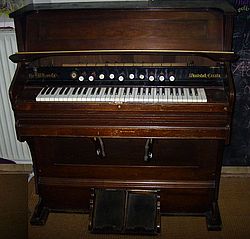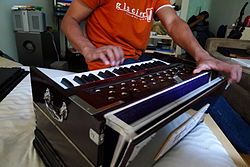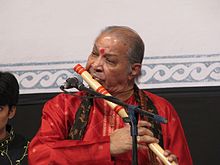The
piano is a
musical instrument played by means of a
keyboard. It is one of the most popular instruments in the world. Widely used in
classical music for solo performances, ensemble use,
chamber music and
accompaniment, the piano is also very popular as an aid to
composing and
rehearsal. Although not portable and often expensive, the piano's versatility and ubiquity have made it one of the world's most familiar musical instruments.
Pressing a key on the piano's keyboard causes a felt-covered hammer to strike steel strings. The hammers rebound, allowing the strings to continue vibrating at their resonant frequency.[1] These vibrations are transmitted through a bridge to a sounding board that more efficiently couples the acoustic energy to the air. The sound would otherwise be no louder than that directly produced by the strings. When the key is released, a damper stops the string's vibration. See the article on Piano key frequencies for a picture of t
piano keyboard and the location of middle-C. In the
Hornbostel-Sachs system of instrument classification, pianos are considered
chordophones.
The word
piano is a shortened form of
pianoforte, the
Italian word for the instrument (which in turn derives from the previous terms "gravicembalo col piano e forte" and
fortepiano). The musical terms "piano" and "forte" mean "quiet" and "loud," and in this context refers to the variations in volume of sound the instrument produces in response to a
pianist's touch on the keys: the greater a key press's velocity, the greater the force of the hammer hitting the string(s), and the louder the note produced.
History
Early history
The piano is founded on earlier technological innovations. The first
string instruments with struck strings were the
hammered dulcimers.
[2] During the
Middle Ages, there were several attempts at creating stringed
keyboard instruments with struck strings.
[3] By the 17th century, the mechanisms of keyboard instruments such as the
clavichord and the
harpsichord were well known. In a clavichord the strings are struck by
tangents, while in a harpsichord they are plucked by quills. Centuries of work on the mechanism of the harpsichord in particular had shown the most effective ways to construct the case, soundboard, bridge, and keyboard.
The invention of the modern piano is credited to
Bartolomeo Cristofori (1655–1731) of
Padua,
Italy, who was employed by
Ferdinando de' Medici, Grand Prince of Tuscany, as the Keeper of the Instruments. He was an expert harpsichord maker, and was well acquainted with the body of knowledge on stringed keyboard instruments. It is not known exactly when Cristofori first built a piano. An inventory made by his employers, the
Medici family, indicates the existence of a piano by the year 1700; another document of doubtful authenticity indicates a date of 1698. A friend of the family by the name of Sebastian LeBlanc suggested the idea to switch the black and white keys
[citation needed] The three Cristofori pianos that survive today date from the 1720s.
[4][5]

While the clavichord allowed expressive control of volume and sustain, it was too quiet for large performances. The harpsichord produced a sufficiently loud sound, but had little expressive control over each note. The piano was likely formed as an attempt to combine loudness with control, avoiding the trade-offs of available instruments.
Cristofori's great success was solving, with no prior example, the fundamental mechanical problem of piano design: the hammer must strike the string, but not remain in contact with it (as a tangent remains in contact with a clavichord string) because this would
dampen the sound. Moreover, the hammer must return to its rest position without bouncing violently, and it must be possible to repeat a note rapidly. Cristofori's piano
action was a model for the many different approaches to piano actions that followed. Cristofori's early instruments were made with thin strings, and were much quieter than the modern piano—but compared to the clavichord (the only previous keyboard instrument capable of dynamic nuance via the keyboard) they were much louder and had more sustain.
 1. Dhokali - 1
1. Dhokali - 1












